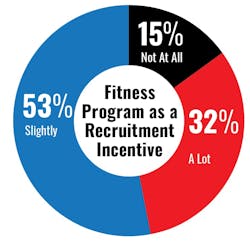The volunteer fire service is a crucial national resource. Effective community fire protection depends on the ability of departments to recruit and retain community members to serve as volunteer firefighters. The organizational style of volunteer departments has a significant history in our country and is a tradition that dates back to the roots of the United States. However, it isn’t a system without limitations.
Although volunteers make up 65 percent of the U.S. fire service, the NFPA reports that the number of volunteer firefighters hit the lowest number on record in 2020. Understaffed departments leave communities, particularly small-town and rural communities that rely almost entirely on volunteers, at increased risk.
To recruit and retain firefighters, many volunteer fire and EMS departments have turned to innovative strategies to improve department staffing levels.
The use of incentives is one strategy that’s employed widely. A volunteer incentive program works to motivate and encourage current staff to remain with the organization and to attract potential new members. Incentives can come in the form of both tangible and nontangible “rewards,” such as employee recognition programs, childcare, gift vouchers, tuition reimbursement, cash bonuses and professional development opportunities. Less utilized is health and fitness programming.
Incentive?
The private sector touts health and fitness programs as a benefit that promotes a healthy workforce, demonstrates value and caring for the workforce, enhances the employee experience and creates a competitive organizational edge, which serve to attract new talent.
In 2022, a small-scale study was conducted to better define the effect that health and fitness programming might have on the recruitment and retention of volunteer firefighters. The central question that the study sought to address was: Can department-sponsored, on-site health and fitness programs act as an incentive to retain current members and attract new members?
A 14-question survey was distributed through the National Volunteer Fire Council’s Volunteer Voices open forum, the Chester County (PA) Fire Chiefs Association and Capstone Public Sector Solutions and to four Minnesota volunteer departments. The questionnaire prompted 141 responses.
Most respondents identified as male, with 47 percent reporting their tenure as 0–10 years and 41 percent reporting their age as 50 years or older.
Primary findings
When asked whether their department offered a formal program, 97 percent indicated that their department didn’t offer an intentionally planned and structured fitness program. However, 86 percent indicated that they would benefit from a fitness program that the department sponsored if it was offered.
Most respondents indicated that their personal health and fitness are important for their work. Yet, although most indicated that they remain “active” on a weekly basis, 57 percent noted that they don’t belong to a private health and fitness center.
When asked whether they would be supportive of a department-sponsored fitness program, 82 percent indicated yes, but several noted that they would be fearful of formal programming if:
- The program was cost prohibitive (12 percent).
- The program required mandatory participation (10 percent).
- The program led to them being judged or embarrassed (7 percent).
- The program led to department direction (7 percent).
Based on survey feedback, departments might consider becoming the health and fitness facility of choice for their members, because many members might believe that their health is important yet most might not belong to a formal fitness facility. By offering this incentive, not only can an organization invest in the health of its members, but it can build mutually rewarding relationships by garnering a renewed interest in the department while supporting the response capability of the membership.
The survey also highlighted the difference between informal and formal fitness programs. Most survey respondents (64 percent) indicated their department has an informal fitness program that consists of exercise equipment that allows members to work out on their own. However, several respondents indicated that this feature is lightly used or that their interest faded after the initial roll out of equipment.
Formalizing the health and fitness initiative offers several advantages. These include:
- The agency retains control of program elements, offering flexibility to manage the program to meet the desired goals.
- Making monitoring program progress easier via a gradual implementation plan.
- Helping to contain cost and to forecast future funding needs.
- Allowing for a graduated design and program development approach.
- Resource allocation that’s based on program goals.
- Permitting programming that’s based on risk stratification.
- Fostering program acceptance.
Many well-intentioned “programs” fail to improve employee health because of indifferent leadership, poor program design and lackluster execution. Failed efforts often are viewed as “just another program” and with little buy-in from those for whom the program is intended to serve.
A strategic planning approach to program design is key to program acceptance and success.
Recruitment and retention
The staffing challenges that many volunteer departments face are rooted in many factors, including the demanding standards that are intrinsic to being a firefighter, changing community demographics, economic pressure, lifestyle change, expansion of department services, and the increase in state and federal training mandates. The time commitment that departments require of volunteer members and, by extension, their family has a significant effect on both recruitment and retention. Many people have less time that they can commit to their volunteer activities, while an increase in services and a decrease in membership might have many departments asking their volunteers to commit more time.
The survey asked two questions that were designed to assess how a structured fitness program might affect the time commitment that a volunteer is willing to give to the department.
- To what degree would a department- sponsored, free, on-site fitness program increase your commitment to your department? Thirty-one percent of respondents indicate “a lot”; 42 percent responded “slightly.”
- To what degree would a department sponsored, free, on-site fitness program that your immediate family could use increase your commitment to your department? Thirty-three percent indicated “a lot”; 45 percent indicated “slightly.”
These results suggest that firefighters view a health and fitness program as an incentive that would increase their commitment to the agency.
The survey asked two questions that were designed to assess the members’ opinion on the availability of a department-provided health and fitness program and its influence on the recruitment of new members.
- I believe that we could attract more potential volunteer members if my department offered a free, on-site fitness program: 67 percent agreed.
- I believe that a dedicated health and fitness program could help to attract new members to my department: 31 percent indicated “a lot”; 53 percent indicated “slightly.”
Departments are in competition with other organizations to attract a diminishing base of potential volunteers. Those departments that demonstrate the advantages that their organization has over others will be more successful in recruiting and retaining members. Added benefits, such as providing formal health and fitness programming, are key to growing the organization.
The bottom line
The adoption of a formal, department-sponsored health and fitness program acts to support a culture that encourages inclusivity and teamwork, improves the health of the workforce, reflects department values, and reduces illness and injury. Health and fitness programs that are adeptly led and well designed deliver a message to potential member candidates and to incumbent members that the organization cares for and values the health of the workforce.
The results of this study are encouraging. Fitness programming as a potent recruitment and retention tool should be considered to improve volunteer department staffing challenges.






